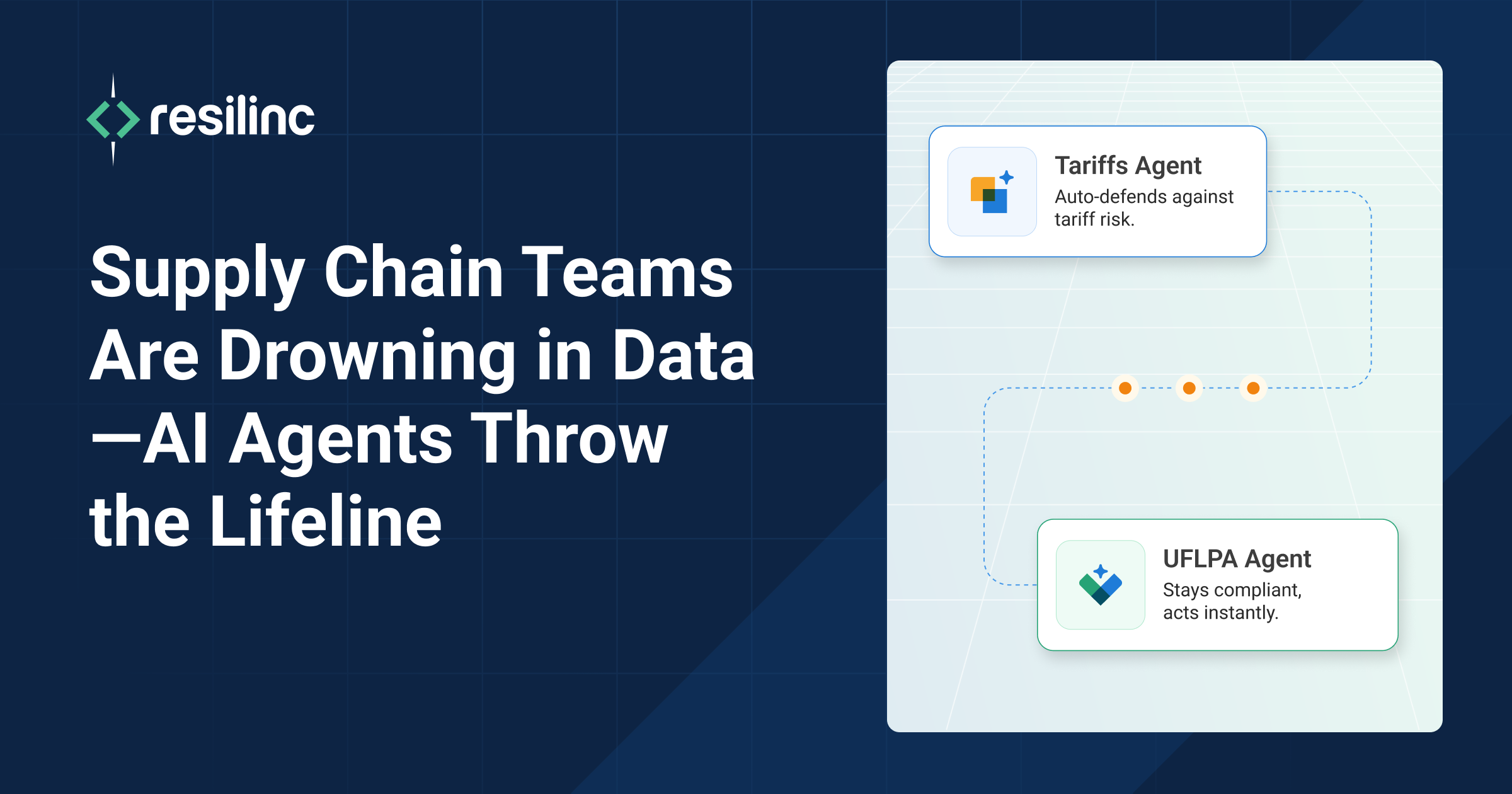Most organizations today are drowning in supply chain data while starving for intelligence they can act on. Risk alerts flood in without automated mitigation pathways. Supplier visibility tools provide network maps but no compliance workflows. Cost modeling systems generate scenarios but offer no sourcing alternatives. Traditional supply chain tools excel at showing you problems but can leave you stranded in the gap between information and action.
This reactive approach doesn’t just hurt margins—it threatens business continuity. Companies need more than alerts and dashboards. They need intelligence that drives immediate, confident action.
Building intelligence on proven foundations
As the first supply chain risk platform to deploy agentic AI, Resilinc has spent the past year learning exactly how AI supply chain risk monitoring agents can bridge this intelligence-action gap. But we’ve discovered something crucial: intelligence without foundation is just sophisticated guesswork.
What sets our approach apart isn’t just the AI—it’s the 15+ years of validated supplier network data, powerful third-party data integration, real customer workflows, and deep regulatory expertise that make Resilinc the single source of truth for supply chain risk management. This isn’t AI for AI’s sake. It’s intelligence that drives measurable business outcomes because it’s built on a foundation of proven, verified supply chain relationships and regulatory understanding.
The enhancements we’re introducing this month represent the evolution of this approach. These aren’t entirely new capabilities—they’re the maturation of our agentic AI platform into agents that don’t just detect risk but orchestrate the entire response from detection through mitigation, including AI-driven tariff monitoring and UFLPA supply chain compliance.
From detection to orchestration
Enhanced tariffs intelligence when every dollar counts
When potential tariffs hit critical components, the clock starts ticking on margin protection. Traditional approaches require manually assessing exposure across hundreds of suppliers and thousands of parts—a process that typically takes weeks and often misses critical dependencies buried in multi-tier networks.
The enhanced Tariffs Agent transforms this timeline with AI-driven tariff monitoring. It instantly models financial impact with unprecedented granular visibility, breaking down exposure by supplier, part, product, and — where mapped — by business unit. The agent runs multiple “what-if” scenarios to help teams prepare contingency plans before policy changes take effect. It identifies the most exposed suppliers and recommends alternative sourcing strategies, complete with risk assessments for each option.
Perhaps most valuable is the agent’s ability to verify supplier claims about tariff-related price increases. When suppliers attempt to capitalize on tariff fears without actual exposure, the agent provides the visibility needed to challenge unjustified cost hikes and maintain accurate pricing.
The business impact is measurable: teams can achieve up to 70% faster response times, protecting margins before they’re hit and maintaining supply continuity through proactive planning rather than reactive firefighting. Want to see the Tariffs Agent in action? View this demo video.
When compliance becomes a competitive advantage
The UFLPA supply chain compliance landscape has become more complex, with Customs and Border Protection (CBP) intensifying enforcement across aluminum, copper, steel, and lithium supply chains. Under the rebuttable presumption framework, companies have just 30 days to prove compliance when shipments are detained—or face destruction or return of goods.
Most organizations are unprepared for this reality. They lack systematic documentation, struggle to trace multi-tier supplier relationships, and find themselves scrambling to compile evidence under extreme time pressure. The result: expensive external counsel, operational delays, and reputational risk.
The enhanced UFLPA Agent transforms this compliance burden into measurable operational advantage. It continuously monitors CBP/DHS entity lists, OpenSanctions databases, and Kharon forced labor data to identify UFLPA exposure across critical materials, tracking not just direct suppliers but the complex multi-tier networks where violations often hide. The agent identifies suppliers and entities with UFLPA exposure that are hidden within multi-tier supply networks—exposure that would be nearly impossible to detect manually.
When risks are identified, the agent launches targeted supplier assessments to collect signed attestations for CBP evidence and recommends compliant alternative suppliers to maintain business continuity. Organizations using the UFLPA Agent can respond to CBP in days instead of weeks, clearing shipments while competitors scramble with manual documentation and expensive legal counsel – setting the new standard for UFLPA supply chain compliance efficiency.
Speed meets accuracy with intelligent network mapping
Resilinc has always been known for our validated supplier mapping—the gold standard for accuracy built through direct supplier engagement over 15+ years. But what happens when you need rapid insights before you can launch a full validation process? This is where our enhanced Autonomous Mapping capabilities shine.
Unlike traditional autonomous mapping approaches that rely solely on publicly available data, Resilinc’s autonomous mapping is trained on our deep knowledge graph of validated supplier relationships, forming the backbone of our AI supply chain risk monitoring capabilities. This foundation of 15+ years of verified supply chain data enables our AI to generate multi-tier supplier networks that are both fast and remarkably accurate.
The system generates complete supplier networks in minutes instead of months, with powerful filtering by companies, materials, geographies, or specific parts to focus analysis where it matters most. Material breakdown functionality provides visibility into raw material exposure across complex supplier tiers. Teams can export results immediately for offline analysis and collaboration.
This isn’t about replacing validated mapping—it’s about providing immediate intelligence that complements and accelerates the validation process. Teams get rapid insights when speed matters, backed by the most accurate supplier data foundation in the industry.
Improved user experience and intelligence at your fingertips
Having powerful capabilities means nothing if they’re buried behind complex interfaces and scattered across multiple systems. For AI supply chain risk monitoring to deliver real value, supply chain professionals need answers, not more charts to interpret. They need action, not additional context-switching between tools.
Instead of hunting through menus and deciphering charts, supply chain professionals can now interact with risk intelligence through natural language. Ask “Which of my suppliers are most exposed to new aluminum tariffs?” or “Show me UFLPA risks in my automotive supply chain” and receive precise answers with recommended actions. The platform provides guided prompts and surfaces the most critical questions for your specific context, helping teams quickly navigate to the insights that matter most.
This conversational interface extends across all agents through a unified access point. Rather than learning separate tools for tariffs, compliance, and network mapping, teams interact with a single intelligent system that understands context and orchestrates responses across capabilities.
The shift from dashboard-driven to conversation-driven intelligence represents more than convenience—it’s a fundamental reimagining of how supply chain professionals should interact with risk data. Technology becomes invisible, leaving teams free to focus on strategic decisions rather than software navigation.
Bringing it all together
The real power of enhanced agentic AI emerges not from individual capabilities, but from how these agents work together to create compound intelligence.
Consider a real-world scenario: The Tariffs Agent identifies significant cost risk from potential new restrictions on a key supplier region. It immediately triggers the Autonomous Mapping capability to reveal alternative suppliers across the same material categories. The UFLPA Agent then validates compliance across this newly mapped alternative network, ensuring any sourcing changes don’t inadvertently create regulatory exposure.
All of this happens through a single, intuitive interface that eliminates context-switching and enables fast decision-making backed by comprehensive intelligence and automated workflows.
This integration creates something greater than the sum of its parts: supply chain intelligence that doesn’t just inform decisions but actively guides teams toward the best outcomes.
Agentic AI supply chain resiliency for a better future
Resilinc’s evolution in supply chain risk management enables a fundamental shift in strategic approach. Instead of reactive risk management that responds to problems after they’ve impacted operations, teams can engage in proactive risk orchestration that prevents problems from materializing. Compliance transforms from a cost center into a strategic differentiator that builds competitive moats. Supply chain agility becomes backed by real-time intelligence and automated workflows rather than heroic manual effort.
The enhanced capabilities we’ve introduced represent more than feature updates—they’re the foundation for a new approach to supply chain risk management where intelligence drives action, agents handle operational complexity, and teams focus on strategic advantage.
Ready to experience agentic AI supply chain resiliency? Schedule a demo to experience intelligent action – today.




